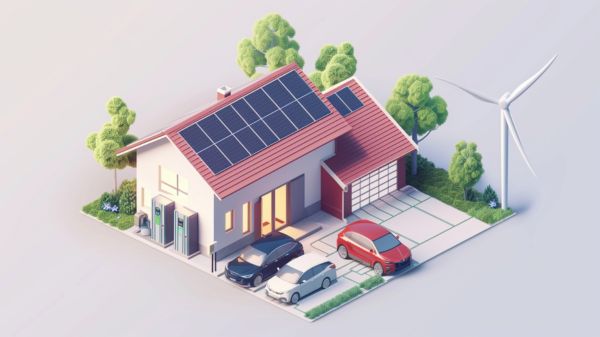With the immense potential to revolutionize the way we manage energy, smart grids are a cornerstone in the domain of green technology. Through their sophisticated capabilities, they offer a pathway towards a more sustainable and efficient energy landscape. But how exactly do these smart grids work their magic? Let’s find out the benefits of smart grids in green technology and explore the intricate mechanisms that make them an essential component.
Key Takeaways
- Smart grids optimize renewable energy utilization.
- Real-time monitoring enhances green technology efficiency.
- Grid flexibility boosts integration of sustainable power systems.
- Advanced technology supports green energy advancements.
- Increased adoption drives innovation in green technology.
Renewable Energy Integration
Smart grids revolutionize the integration of renewable energy sources into the electrical grid, optimizing efficiency and reliability. By leveraging smart grid technology, the seamless incorporation of renewable generation such as solar and wind power becomes achievable.
Real-time monitoring plays a pivotal role in this process, allowing for immediate adjustments to guarantee the best utilization of renewable energy. These advancements not only enhance the overall efficiency of the grid but also contribute to its stability.
Through the utilization of smart grids, both customer-owned and large-scale renewable energy systems can be integrated, enhancing grid flexibility. This integration not only aids in balancing the supply and demand of electricity but also promotes grid stability.
Peak Demand Reduction
Implementing demand response programs and load shifting strategies facilitates peak demand reduction within the electrical grid.
Smart grid systems leverage advanced technology to monitor and optimize energy consumption patterns, allowing for more efficient management of peak demands. By actively adjusting electricity usage during high-demand periods, smart grids help lower energy consumption and reduce strain on the grid infrastructure.
Peak demand reduction achieved through smart grid implementations not only enhances grid reliability but also leads to significant cost savings for consumers. Real-time monitoring and control capabilities enable utilities to better match energy supply with demand, resulting in improved grid efficiency and reduced operational costs.
Furthermore, smart grids optimize energy storage and grid operations, contributing to overall peak demand reduction. By intelligently managing electricity flow and distribution, smart grid systems play an essential role in promoting sustainability and enhancing the resilience of the electrical grid.
Electricity Transmission Efficiency
Improving electricity transmission efficiency is essential for optimizing grid performance and reducing energy losses. Here’s how smart grid technologies enhance the efficiency of electricity transmission:
- Optimization through Digital Technologies: Smart grids utilize digital tools to streamline electricity transmission, reducing energy wastage.
- Real-Time Monitoring and Control: By constantly monitoring and adjusting electricity supply and demand, smart grids improve grid stability and efficiency.
- Automatic Rerouting and Monitoring: Smart grids can quickly reroute electricity and monitor disturbances, minimizing downtime and enhancing overall efficiency.
- Integration of Renewable Energy Sources: Incorporating renewable energy sources into smart grids not only supports green technology initiatives but also boosts electricity transmission efficiency by diversifying energy generation sources.
These advancements in smart grid technologies not only contribute to a more sustainable energy generation landscape but also pave the way for a more efficient and reliable electricity transmission system.
Grid Reliability Enhancement
Enhancing grid reliability involves leveraging advanced monitoring and maintenance strategies to guarantee efficient and uninterrupted electricity supply. Smart grids play an important role in enhancing grid reliability by offering real-time monitoring and predictive maintenance capabilities.
These grids have self-healing features that help minimize outages and reduce downtime, ensuring a more resilient energy infrastructure. Integration of microgrids and energy storage systems further improves grid resilience, allowing for better management of electricity supply during peak demand or emergencies.
Advanced analytics are utilized within smart grids to optimize grid operations and maintenance, leading to improved reliability and performance. Additionally, smart grids enable automatic rerouting and monitoring, facilitating quicker restoration of electricity after power disturbances.
Industry Innovation Collaboration
Smart grids play a pivotal role in fostering industry innovation collaboration within the energy sector through platforms like BizClik brand and Energy Magazine Features. These platforms connect energy executives globally, providing digital hubs, media, events, and research reports to showcase the latest energy trends and offer valuable insights for building robust infrastructure.
By embracing innovative technologies for energy distribution stability and guaranteeing uninterrupted power supply to consumers, these collaborations drive sustainable advancements in green technology.
Here are four ways in which industry innovation collaboration is enhanced through smart grids:
- Global Connectivity: Platforms like BizClik brand and Energy Magazine Features connect energy professionals worldwide, facilitating knowledge exchange and collaboration.
- Trend Showcasing: These platforms showcase the latest energy trends, enabling industry professionals to stay informed and drive innovation in green technology.
- Technological Embrace: By embracing innovative technologies, the energy sector guarantees stability in energy distribution, contributing to the advancement of green technology.
- Knowledge Sharing: Industry collaborations foster knowledge sharing among professionals, driving sustainable practices and advancements in the energy sector.
Advantages for Green Technology
Smart grids offer significant advantages for green technology. They improve efficiency in energy distribution, integrate renewable sources like solar and wind power effectively and provide real-time monitoring benefits. These capabilities are essential in advancing sustainability and reducing carbon emissions for a greener future.
Efficiency in Energy
By enhancing energy efficiency, smart grids offer significant advantages for the adoption of green technology. Here’s how smart grids drive efficiency in energy:
- Reduced Energy Consumption: Smart grids enable optimized energy distribution, leading to lower energy consumption for end-users.
- Integration of Renewable Sources: Smart grids facilitate the seamless integration of renewable energy sources like solar and wind power, promoting sustainable energy practices.
- Real-time Monitoring and Control: The real-time monitoring capabilities of smart grids help in optimizing energy usage, reducing waste, and minimizing environmental impact.
- Demand Response Management: Smart grids allow for efficient management of electricity consumption during peak periods through demand response strategies, aiding in the advancement of green technology initiatives.
These features showcase how smart grids play a pivotal role in enhancing energy efficiency, supporting the shift towards a more sustainable and eco-friendly energy landscape.
Renewable Source Integration
Enhancing green technology, the integration of renewable energy sources into smart grids offers significant advantages for promoting sustainability and efficiency in energy utilization.
Smart grids play an important role in seamlessly incorporating renewable sources like solar and wind power into the existing grid infrastructure. By enabling real-time monitoring and adjustments, smart grids optimize the utilization of renewable energy, thereby enhancing green technology applications.
These grids facilitate the integration of both customer-owned and large-scale renewable energy systems, fostering a more diversified and sustainable energy mix.
Additionally, smart grids enhance grid flexibility and stability by efficiently integrating renewable sources with conventional power sources. This integration promotes the efficient transmission and utilization of renewable energy, promoting reliability and cost savings in green technology implementations.
Real-Time Monitoring Benefits
Real-time monitoring of renewable energy sources in smart grids greatly enhances the efficiency and sustainability of green technology applications. Smart grids enable the continuous monitoring of renewable sources like solar and wind power, optimizing their utilization for maximum benefit.
Here are four key benefits of real-time monitoring in green technology:
- Essential Utilization: Smart grids allow for adjustments in energy production and consumption in real-time, ensuring that renewable sources are utilized efficiently.
- Integration Efficiency: Real-time monitoring facilitates the seamless integration of customer-owned renewable energy systems into the grid, improving overall system efficiency.
- Grid Flexibility: By monitoring and controlling green technology applications, smart grids enhance grid flexibility and stability, ensuring reliable energy supply.
- Sustainable Power Systems: Monitoring renewable energy sources in real-time enables the efficient transmission and utilization of green energy, contributing to the development of sustainable power systems.
These benefits underscore the essential role of real-time monitoring in advancing green technology and achieving a more sustainable energy landscape.
Career Guidance Locations
Exploring career guidance locations for engineering professionals can open doors to abundant opportunities and resources in cities like Texas, Florida, Atlanta, Portland, and Chicago.
These hubs not only offer a thriving environment for professionals in the engineering industry but also provide access to a range of green technology and smart grid projects. By considering these locations, you position yourself at the forefront of innovation and sustainability within the engineering field.
To further emphasize the importance of these career guidance locations, below is a table highlighting key cities where engineering professionals can find exciting prospects and substantial growth opportunities:
| City | Opportunities Available |
|---|---|
| Texas | Smart Grid Projects |
| Florida | Green Technology Initiatives |
| Atlanta | Sustainable Engineering Roles |
| Portland | Renewable Energy Projects |
| Chicago | Environmental Engineering Positions |
Choosing to explore career options in these cities can significantly impact your career trajectory, allowing you to contribute to the advancement of green technology and smart grid solutions in the engineering industry.
Engineering Recruiters in Cities
Career guidance locations for engineering professionals not only offer abundant opportunities and resources but also attract engineering recruiters actively seeking talent in cities like Huntsville and Seattle.
Engineering recruiters play an essential role in connecting skilled professionals with rewarding career opportunities, especially in the ever-evolving landscape of smart grids and increasing energy demands.
Here are four key insights into the role of engineering recruiters in cities:
- Strategic Talent Acquisition: Engineering recruiters strategically scout for top talent in cities like Huntsville and Seattle to meet the growing demands of the smart grid industry.
- Industry Networking: Recruiters in cities such as Charlotte, Raleigh, and Nashville establish strong industry connections to bridge the gap between skilled engineers and innovative companies.
- Career Advancement: Career prospects in engineering are booming in locations like Cincinnati, Columbus, and St. Louis, where recruiters facilitate career advancements for professionals.
- Driving Innovation: Industry-focused recruitment efforts in key cities aim to bolster the engineering workforce and drive innovation in the sector, meeting the evolving needs of the smart grid industry.
Career Opportunities in Engineering
Numerous engineering career opportunities await professionals in cities such as Cincinnati, Columbus, Greenville, and St. Louis. These cities, along with top American hubs like Huntsville, Charlotte, Raleigh, Nashville, and Seattle, have established engineering recruiters actively seeking talent.
The increasing adoption of smart grid technology in states like Texas, Florida, Atlanta, Portland, and Chicago has further amplified the demand for engineering expertise. Industry events such as BizClik’s Sustainability LIVE 2024 provide valuable insights and networking opportunities for aspiring engineering professionals looking to explore the smart grid sector.
With a focus on renewable energy integration, grid reliability, and maintenance advancements, smart grids offer diverse career paths for engineers passionate about sustainability and innovation. Embracing these opportunities can lead to impactful roles in shaping the future of energy infrastructure and environmental conservation.
As the smart grid industry continues to evolve, engineers play an essential role in driving progress and making a significant difference in the green technology landscape.
Conclusion
Congratulations, you have found the benefits of smart grids in green technology and have now mastered the intricate web of how they enhance green technology. Armed with this knowledge, you’re equipped to navigate the ever-evolving landscape of sustainable energy solutions.
Remember, the future is bright, and with smart grids leading the way, the possibilities for a greener, cleaner world are endless. So go forth, spread the word, and continue to champion the cause of green technology with confidence and expertise.




